
STS-119
Encyclopedia
Crew notes
This mission was originally scheduled to bring the Expedition 9Expedition 9
Expedition 9 was the 9th expedition to the International Space Station.-Crew:-Mission parameters:*Perigee: 384 km*Apogee: 396 km*Inclination: 51.6°*Period: 92 minthumb|left|250px|Edward M...
crew to the ISS. This crew would have consisted of:
Mission parameters
- MassMassMass can be defined as a quantitive measure of the resistance an object has to change in its velocity.In physics, mass commonly refers to any of the following three properties of matter, which have been shown experimentally to be equivalent:...
: - Orbiter liftoff: 266448 pounds (120,858.8 kg)
- Orbiter landing: 200986 pounds (91,165.7 kg)
- PerigeePerigeePerigee is the point at which an object makes its closest approach to the Earth.. Often the term is used in a broader sense to define the point in an orbit where the orbiting body is closest to the body it orbits. The opposite is the apogee, the farthest or highest point.The Greek prefix "peri"...
: 217 nautical miles (401.9 km) - Apogee: 208 nautical miles (385.2 km)
- PeriodOrbital periodThe orbital period is the time taken for a given object to make one complete orbit about another object.When mentioned without further qualification in astronomy this refers to the sidereal period of an astronomical object, which is calculated with respect to the stars.There are several kinds of...
: 91.6 minutes - Launch windowLaunch windowLaunch window is a term used in spaceflight to describe a time period in which a particular launch vehicle must be launched. If the rocket does not launch within the "window", it has to wait for the next window....
: 10 minutes - Landing Site: Kennedy Space CenterKennedy Space CenterThe John F. Kennedy Space Center is the NASA installation that has been the launch site for every United States human space flight since 1968. Although such flights are currently on hiatus, KSC continues to manage and operate unmanned rocket launch facilities for America's civilian space program...
(KSC)
Mission payload
STS-119 delivered the S6 solar arrays to the space stationInternational Space Station
The International Space Station is a habitable, artificial satellite in low Earth orbit. The ISS follows the Salyut, Almaz, Cosmos, Skylab, and Mir space stations, as the 11th space station launched, not including the Genesis I and II prototypes...
, completing the construction of the Integrated Truss Structure
Integrated Truss Structure
the Integrated Truss Structure forms the backbone of the International Space Station, with mountings for unpressurized logistics carriers, radiators, solar arrays, and other equipment.-History:...
. STS-119 also carried several experiments, including the Shuttle Ionospheric Modification with Pulsed Local EXhaust (SIMPLEX), Shuttle Exhaust Ion Turbulence Experiments (SEITE), and Maui Analysis of Upper Atmospheric Injections (MAUI).
STS-119 was also used for the "Boundary Layer Transition Detailed Test Objective" experiment. One tile of the thermal protection system was raised 0.25 inches (6.4 mm) above the others so that, at about Mach
Mach number
Mach number is the speed of an object moving through air, or any other fluid substance, divided by the speed of sound as it is in that substance for its particular physical conditions, including those of temperature and pressure...
15 during reentry, a boundary layer transition
Boundary layer transition
The process of a laminar boundary layer becoming turbulent is known as boundary layer transition. This process is an extraordinarily complicated process which at present is not fully understood...
would be initiated. This experiment was repeated during STS-128
STS-128
-Crew notes:Nicole Stott was originally scheduled to return aboard Soyuz TMA-15, but a change in the flight plan was made due to the possible flight delays in future shuttle missions, which may extend Canadian astronaut Robert Thirsk's mission beyond the six-month duration preferred for station...
with the tile raised to 0.35 inches (8.9 mm), tripping at Mach 18 to produce more heat.
| Location | Cargo | Mass |
|---|---|---|
| Bays 1–2 | Orbiter Docking System EMU Extravehicular Mobility Unit The Space Shuttle/International Space Station Extravehicular Mobility Unit is an independent anthropomorphic system that provides environmental protection, mobility, life support, and communications for a Space Shuttle or International Space Station crew member to perform extra-vehicular activity... 3017 / EMU 3006 |
1800 kilograms (3,968.3 lb) ~260 kilograms (573.2 lb) |
| Bay 3P | Shuttle Power Distribution Unit (SPDU) |
~17 kilograms (37.5 lb) |
| Bays 3–13 | S6 Truss | 14088 kilograms (31,058.7 lb) |
| Starboard Sill | Orbiter Boom Sensor System Orbiter Boom Sensor System The Orbiter Boom Sensor System is a 50-foot boom carried on board NASA's Space Shuttles. The boom can be grappled by the Canadarm and serves as an extension of the arm, doubling its length to a combined total of 100 feet... |
~382 kilograms (842.2 lb) |
| Port Sill | Canadarm 202 | 410 kilograms (903.9 lb) |
| Total: | 16957 kilograms (37,383.8 lb) |
Mission background
- 156th NASA manned space flight
- 125th shuttle mission since STS-1STS-1STS-1 was the first orbital flight of NASA's Space Shuttle program. Space Shuttle Columbia launched on 12 April 1981, and returned to Earth on 14 April, having orbited the Earth 37 times during the 54.5-hour mission. It was the first American manned space flight since the Apollo-Soyuz Test Project...
- 36th Flight of Discovery
- 100th post-ChallengerSpace Shuttle ChallengerSpace Shuttle Challenger was NASA's second Space Shuttle orbiter to be put into service, Columbia having been the first. The shuttle was built by Rockwell International's Space Transportation Systems Division in Downey, California...
mission - 12th post-ColumbiaSpace Shuttle ColumbiaSpace Shuttle Columbia was the first spaceworthy Space Shuttle in NASA's orbital fleet. First launched on the STS-1 mission, the first of the Space Shuttle program, it completed 27 missions before being destroyed during re-entry on February 1, 2003 near the end of its 28th, STS-107. All seven crew...
mission - 28th shuttle mission to the International Space Station
Shuttle processing
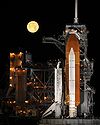
Orbiter Processing Facility
An Orbiter Processing Facility was one of three hangars where U.S. space shuttle orbiters underwent maintenance between flights. All three such facilities, OPF-1, OPF-2 and OPF-3, were located at NASA's Kennedy Space Center in Florida at Launch Complex 39.They were located west of the Vehicle...
to the Vehicle Assembly Building
Vehicle Assembly Building
The Vehicle Assembly Building, or VAB, at NASA's Kennedy Space Center was used to assemble and house American manned launch vehicles from 1968-2011. It is the fourth largest building in the world by volume...
on 7 January 2009. The payload of the S6 truss segment, solar arrays and batteries were delivered to Launch pad 39A on 11 January. Discovery moved to the launch pad 39A on 14 January 2009. The move began at 05:17 EST, and was completed at 12:16 EST.
The STS-119 crew was at Kennedy Space Center
Kennedy Space Center
The John F. Kennedy Space Center is the NASA installation that has been the launch site for every United States human space flight since 1968. Although such flights are currently on hiatus, KSC continues to manage and operate unmanned rocket launch facilities for America's civilian space program...
from 19–22 January 2009 for the Terminal Countdown Demonstration Test
Terminal countdown demonstration test
A terminal countdown demonstration test is a simulation of the final hours of a launch countdown and serves as a practice exercise in which both the launch team and flight crew rehearse launch day timelines and procedures...
. On 21–22 January 2009, mission managers met for the program level Flight Readiness Review (FRR). Following the FRR, mission managers recommended evaluating the hydrogen flow control valves on Discovery, and set a new target launch date of 19 February 2009.

STS-126
-Crew notes:Originally scheduled to fly on STS-126 was Joan E. Higginbotham, who was a mission specialist on STS-116. On 21 November 2007, NASA announced a change in the crew manifest due to Higginbotham's decision to leave NASA to take a job in the private sector. Stephen G...
, the flow valves of all orbiters were subjected to tests to determine if Discovery was safe to fly. These valves are used to synchronize the flow of gaseous hydrogen between the external fuel tank
Space Shuttle external tank
A Space Shuttle External Tank is the component of the Space Shuttle launch vehicle that contains the liquid hydrogen fuel and liquid oxygen oxidizer. During lift-off and ascent it supplies the fuel and oxidizer under pressure to the three Space Shuttle Main Engines in the orbiter...
and the Space Shuttle Main Engine
Space Shuttle main engine
The RS-25, otherwise known as the Space Shuttle Main Engine , is a reusable liquid-fuel rocket engine built by Pratt & Whitney Rocketdyne for the Space Shuttle, running on liquid hydrogen and oxygen. Each Space Shuttle was propelled by three SSMEs mated to one powerhead...
s, creating an even flow. Following the testing of the valves, mission managers decided to postpone the launch, and engineers were asked to replace the suspect flow valves with valves that had less flight time.
Following the replacement of the valves, the Mission Management Team gave the approval for launch, and scheduled it for 11 March 2009. The astronauts arrived at the Kennedy Space Center on 8 March 2009 to prepare for launch. The 11 March 2009 launch was scrubbed due to a leak in a liquid hydrogen vent line between the shuttle and the external tank. On 15 March 2009, the shuttle successfully lifted off from pad 39A. The leak problem manifested itself again during STS-127
STS-127
STS-127 was a NASA Space Shuttle mission to the International Space Station . It was the twenty-third flight of . The primary purpose of the STS-127 mission was to deliver and install the final two components of the Japanese Experiment Module: the Exposed Facility , and the Exposed Section of the...
which lead to a thorough test. The root cause was found to be a misalignment in the GUCP (Ground Umbilical Carrier Plate) which was set right leading to a successful flight.
15 March (Flight day 1, Launch)
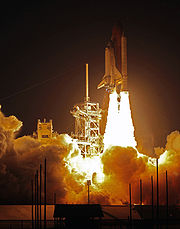
William H. Gerstenmaier
William H. Gerstenmaier has been the Associate Administrator for Space Operations for NASA since 2005. Prior to being Associate Administrator, Gerstenmaier served as the International Space Station Office Program Manager, at Johnson Space Center, a position he began in June 2002.-Early...
, Associate Administrator for Space Operations, during the post-launch news conference. "I’ve seen a lot of launches," commented Launch Director Michael D. Leinbach
Michael D. Leinbach
Michael D. Leinbach was the Shuttle Launch Director at NASA's John F. Kennedy Space Center , Florida. He was responsible for activities in the overall shuttle launch countdown, including planning, policy, and execution.-Early life:...
during the conference, "and this was the most visibly beautiful launch I’ve ever seen." After reaching orbit, the STS-119 crew got to work on their orbit operations, opening the payload bay doors, deploying the Ku band
Ku band
The Kμ band is a portion of the electromagnetic spectrum in the microwave range of frequencies. This symbol refers to —in other words, the band directly below the K-band...
antenna, and activating and checking out the shuttle's robotic arm. The crew also downlinked the imagery taken of the external tank separation.
Bat stowaway
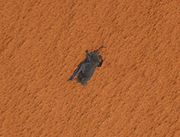
Bat
Bats are mammals of the order Chiroptera "hand" and pteron "wing") whose forelimbs form webbed wings, making them the only mammals naturally capable of true and sustained flight. By contrast, other mammals said to fly, such as flying squirrels, gliding possums, and colugos, glide rather than fly,...
was seen to be resting on the external tank. What was originally believed to be a fruit bat
Fruit Bat
Fruit Bat can refer to:* Megabats, a species of bat which eats fruit* Les "Fruitbat" Carter, guitarist of Carter the Unstoppable Sex Machine* Fruit Bats , an American band...
was revealed to have been a free-tailed bat
Free-tailed bat
Molossidae, or free-tailed bats, are a family of bats within the order Chiroptera. They are generally quite robust, and consist of many strong flying forms with relatively long and narrow wings. Another common name for some members of this group, and indeed a few species from other families, is...
that clung onto the fuel tank during the launch. NASA observers had believed the bat would fly off once the shuttle started to launch, but it did not, and it was probably shaken off and incinerated by the rocket exhaust. A bat doctor, analyzing pictures, believed the bat had a broken wing which made it unable to fly off.
16 March (Flight day 2)
Following the crew's wakeup call, the members of STS-119 set to work on the day's task of inspecting Discovery's thermal protection systemSpace Shuttle thermal protection system
The Space Shuttle thermal protection system is the barrier that protects the Space Shuttle Orbiter during the searing heat of atmospheric reentry...
. Using the shuttle's robotic arm and the Orbiter Boom Sensor System
Orbiter Boom Sensor System
The Orbiter Boom Sensor System is a 50-foot boom carried on board NASA's Space Shuttles. The boom can be grappled by the Canadarm and serves as an extension of the arm, doubling its length to a combined total of 100 feet...
(OBSS), the crew performed the five hour inspection, and the images and video from the survey would be reviewed by the image analysis team on the ground. In preparation for docking with the space station on flight day three, the crew performed a checkout of the spacesuits
Extravehicular Mobility Unit
The Space Shuttle/International Space Station Extravehicular Mobility Unit is an independent anthropomorphic system that provides environmental protection, mobility, life support, and communications for a Space Shuttle or International Space Station crew member to perform extra-vehicular activity...
that would be used during the mission, as well as extending the ring of the orbital docking system
Androgynous Peripheral Attach System
The Androgynous Peripheral Attach System, or Androgynous Peripheral Assembly System, is a spacecraft docking mechanism used on the International Space Station. It is used to dock the Space Shuttle orbiter and to connect the Functional Cargo Block to Pressurized Mating Adapter-1...
, and installing the docking system's centerline camera.
Initial review of the flight ascent imagery indicated no major problems with foam loss or debris strikes to the orbiter. During the day's Mission Management Team briefing, chairman LeRoy Cain
LeRoy E. Cain
Leroy E. Cain is a NASA engineer. Formerly a flight director, he became the manager of Space Shuttle Launch Integration at Kennedy Space Center in November 2005....
noted that the launch was "picture perfect" and the orbiter was in excellent condition. Cain also noted that after an initial review of the telemetry from the launch, the hydrogen flow control valves performed as expected, with no issues seen.
17 March (Flight day 3)
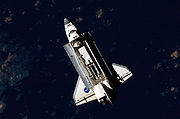
Rendezvous pitch maneuver
The R-bar pitch maneuver , popularly called the rendezvous pitch maneuver, was a maneuver performed by the space shuttle as it rendezvoused with the International Space Station prior to docking. The shuttle performed a backflip that exposed its heat-shield to the crew of the ISS that made...
(RPM) to allow the Expedition 18 crew to photograph the underside of the orbiter, Discovery successfully docked with the station at 21:20 UTC. Following hatch leak checks, the hatches were opened at 23:09 UTC. After greeting each other, the crews had a mandatory station safety briefing, and then set to work with initial transfers, including the exchange of Magnus' Soyuz seat liner for Wakata's. The swap of the seat liners marked Wakata officially joining the Expedition 18 crew as Flight Engineer, and Magnus became a Mission Specialist for STS-119.
During the Mission Status briefing, Lead Flight Director Paul Dye commended Archambault on a picture perfect docking. Dye said that no major issues or anomalies were being tracked, but noted that the image analysis team was still working on ascent imagery, and would be reviewing the RPM imagery before making a decision as to whether Discovery would require a focused inspection.
18 March (Flight day 4)

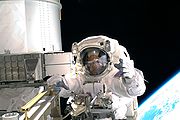
The station arm was then moved along the mobile base to a work site on the far right side, closer to the installation point. The shuttle's robotic arm then handed the truss back to the station's arm, where it remained overnight.
The crews took part in a media event with Channel One News, and performed a review of the procedures for the first EVA. Mission Specialists Swanson and Arnold spent the night in the Quest airlock camping out in a reduced-nitrogen atmosphere, a standard procedure designed for spacewalkers to prevent decompression symptoms.
During the Mission Management Team briefing, Lead ISS Flight Director Kwatsi Alibaruho
Kwatsi Alibaruho
Kwatsi Alibaruho is a Flight Director for the National Aeronautics and Space Administration. He is the first African American NASA Flight Director....
noted that the imagery specialists with the Damage Assessment Team had completed the initial review of the launch and flight day 2 photography, and a focused inspection of the orbiter would not be required.
19 March (Flight day 5, Spacewalk 1)
The two crews set to work following their wake up call, preparing for the first spacewalk of the mission. Swanson and Arnold exited the Quest airlock at 16:22 UTC to begin the installation of the S6 truss segment. Once Swanson and Arnold were in position, Phillips and Wakata remotely controlled the station's robotic arm, maneuvering the truss into its final position. Swanson and Arnold then bolted the truss into place, and connected power and data cables, which allowed the ground team to begin remote activation of the segment. The two spacewalkers also removed launch locks, stowed a keel pin, removed and jettisoned four thermal covers, and deployed the blanket boxes that hold the solar arrays in place during launch. The spacewalk ended at 21:11 UTC, for a total time of 6 hours, 7 minutes.Initially scheduled for flight day 8, managers on the ground decided to move up the deployment of the solar arrays, following the decision that a focused inspection would not be required. It was decided that the deployment of the arrays would be performed on flight day 6, prior to the mission's second spacewalk, in case any issues arose that required a spacewalk to resolve.
20 March (Flight day 6)
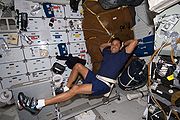

The unfurling of the arrays started at 15:06 UTC, beginning with the channel 1B array. Commanding the unit from the station, Philips paused at the halfway point, and allowed the array to rest in the sun for approximately 45 minutes, and then completed the extension. After successfully extending the 1B array, the astronauts started the 3B array extension at 16:35 UTC. The 3B array was expected to be more difficult to extend, as it had been packed in the blanket box for eight years. As with the first, a pause at halfway was performed to allow the arrays to heat up in the sun. While some stiction was seen, once the final extension began all the slats flattened out, and the arrays were fully deployed at 17:17 UTC. The addition of the final set of solar panels brings the station's power output to 120 kilowatts, and doubles the scientific power to 30 kilowatts. The station's surface area of the arrays is just under one acre, or 38,400 square feet.
Later in the day, Fincke, Lonchakov, Wakata and Magnus participated in a media event with Reuters
Reuters
Reuters is a news agency headquartered in New York City. Until 2008 the Reuters news agency formed part of a British independent company, Reuters Group plc, which was also a provider of financial market data...
, Voice of America
Voice of America
Voice of America is the official external broadcast institution of the United States federal government. It is one of five civilian U.S. international broadcasters working under the umbrella of the Broadcasting Board of Governors . VOA provides a wide range of programming for broadcast on radio...
, and the Pittsburgh Post-Gazette
Pittsburgh Post-Gazette
The Pittsburgh Post-Gazette, also known simply as the "PG," is the largest daily newspaper serving metropolitan Pittsburgh, Pennsylvania, USA.-Early history:...
.
During the Mission Status briefing, Alibaruho expressed how pleased the teams on the ground were with the successful deployment of the arrays, and commended the crew on the deployment activities. Mission Management Team Chairman LeRoy Cain noted that the team was working on a revised timetable to allow critical experiment samples to return to earth safely. The samples need to be kept in a cold environment, and in the event weather delayed the landing, the team evaluated the best way to preserve the samples. The team approved a revised flight plan that allows Discovery to delay hatch closure and undocking slightly, to allow the samples to be kept inside the station's freezer longer, while still protecting the landing date of 28 March. Instead of closing the hatch the night before undocking, the hatch would be closed on the same day, flight day eleven.
21 March (Flight day 7, Spacewalk 2)
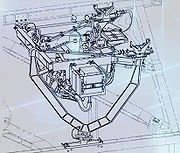
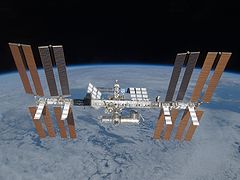
STS-127
STS-127 was a NASA Space Shuttle mission to the International Space Station . It was the twenty-third flight of . The primary purpose of the STS-127 mission was to deliver and install the final two components of the Japanese Experiment Module: the Exposed Facility , and the Exposed Section of the...
spacewalkers could more easily change out the Port 6 truss batteries later this year. On the Japanese Kibo laboratory
Japanese Experiment Module
The Japanese Experiment Module , also known with the nickname , is a Japanese science module for the International Space Station developed by JAXA. It is the largest single ISS module. The first two pieces of the module were launched on space shuttle missions STS-123 and STS-124...
they installed a second Global Positioning Satellite antenna. They photographed areas of radiator panels extended from the Port 1 and Starboard 1 trusses and reconfigured connectors at a patch panel on the Zenith 1 truss that power Control Moment Gyroscopes. After struggling with a pin that kept an Unpressurized Cargo Carrier Attachment System (UCCAS) from fully deploying, they tied UCCAS safely in place. The spacewalk ended at 23:21 UTC, for a time of six hours and thirty minutes.
22 March (Flight day 8)
At 20:31 UTC, Discovery rotated the shuttle-station complex 180 degrees, to avoid a piece of orbital debris. At 23:23, Discovery began rotating the station back to normal attitude, with the shuttle in 'back'.Fincke continued to work on the Urine Processor Assembly, while Acaba and Arnold entered the Quest Airlock to prepare for the mission's third spacewalk.
23 March (Flight day 9, Spacewalk 3)
Acaba and Arnold completed the mission's third spacewalk. They helped robotic arm operators relocate the Crew Equipment Translation Aid (CETA) cart from the Port 1 to Starboard 1 truss segment, installed a new coupler on the CETA cart, and lubricated snares on the space station's robotic arm.They were unable to deploy the Port 3 unpressurized cargo carrier attachment system (UCCAS). They secured the UCCAS in place until engineers can evaluate the problem. Mission Control cancelled the installation of a similar payload attachment system on the starboard side. The port UCCAS was deployed successfully during STS-127
STS-127
STS-127 was a NASA Space Shuttle mission to the International Space Station . It was the twenty-third flight of . The primary purpose of the STS-127 mission was to deliver and install the final two components of the Japanese Experiment Module: the Exposed Facility , and the Exposed Section of the...
by releasing the stuck pin with a custom made tool.
The spacewalk lasted six hours, 27 minutes. It began at 15:37 UTC and concluded at 22:04 UTC.
24 March (Flight day 10)

United States Congress
The United States Congress is the bicameral legislature of the federal government of the United States, consisting of the Senate and the House of Representatives. The Congress meets in the United States Capitol in Washington, D.C....
, and students during a joint news conference.
25 March (Flight day 11)
Crew members from space shuttle Discovery and the International Space Station closed their respective hatches at 17:59 UTC. The space shuttle undocked from the International Space Station at 19:53 UTC.26 March (Flight day 12)
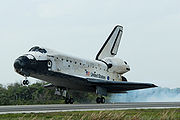
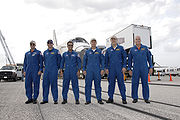
27 March (Flight day 13)
The crew stowed items in the crew cabin and completed a check out the orbiter's flight control surfaces.28 March (Flight day 14, Landing)
Following the wake up call, the crew on board Discovery got to work preparing for entry. After the first landing opportunity was waved off due to high wind concerns, the team on the ground gave the crew a 'go' to proceed with the second opportunity. Following the deorbit burn, the orbiter landed successfully at 15:13 EDT.Extra-vehicular activity
Three spacewalksExtra-vehicular activity
Extra-vehicular activity is work done by an astronaut away from the Earth, and outside of a spacecraft. The term most commonly applies to an EVA made outside a craft orbiting Earth , but also applies to an EVA made on the surface of the Moon...
were scheduled and completed during STS-119. The cumulative time in extra-vehicular activity during the mission was 19 hours and 4 minutes.
| EVA | Spacewalkers | Start (UTC Coordinated Universal Time Coordinated Universal Time is the primary time standard by which the world regulates clocks and time. It is one of several closely related successors to Greenwich Mean Time. Computer servers, online services and other entities that rely on having a universally accepted time use UTC for that purpose... ) |
End (UTC) | Duration |
|---|---|---|---|---|
| EVA 1 | Steven R. Swanson Steven Swanson Steven Ray Swanson is an American engineer and a NASA astronaut. Swanson is married and has 3 children. Steven has received numerous awards and honors. These include the NASA Exceptional Achievement Medal and the JSC Certificate of Accommodation and many others... Richard R. Arnold Richard R. Arnold Richard Robert "Ricky" Arnold II is an American educator and a NASA astronaut. He flew on Space Shuttle mission STS-119, which launched March 15, 2009 and delivered the final set of solar arrays to the International Space Station.Arnold was raised in Bowie, Maryland and is married to Eloise... |
19 March 2009 17:16 |
19 March 2009 23:23 |
6 hours, 7 minutes |
| Installed the Starboard 6 (S6) truss to the S5 truss, connected S5/S6 umbilicals, released launch restraints, removed keel pins, stored and removed thermal covers, and deployed the S6 photovoltaic radiator. | ||||
| EVA 2 | Swanson Joseph M. Acaba Joseph M. Acaba Joseph Michael "Joe" Acaba is an educator, hydrogeologist, and NASA astronaut. In May 2004 he became the first person of Puerto Rican heritage to be named as a NASA astronaut candidate, when he was selected as a member of NASA Astronaut Training Group 19... |
21 March 2009 16:51 |
21 March 2009 23:21 |
6 hours, 30 minutes |
| Advanced preparation of a worksite for STS-127 STS-127 STS-127 was a NASA Space Shuttle mission to the International Space Station . It was the twenty-third flight of . The primary purpose of the STS-127 mission was to deliver and install the final two components of the Japanese Experiment Module: the Exposed Facility , and the Exposed Section of the... , partial installation of an unpressurized cargo carrier attachment system on the P3 truss, installation of a Global Positioning System Global Positioning System The Global Positioning System is a space-based global navigation satellite system that provides location and time information in all weather, anywhere on or near the Earth, where there is an unobstructed line of sight to four or more GPS satellites... antenna Antenna (radio) An antenna is an electrical device which converts electric currents into radio waves, and vice versa. It is usually used with a radio transmitter or radio receiver... to the Kibo Japanese Experiment Module The Japanese Experiment Module , also known with the nickname , is a Japanese science module for the International Space Station developed by JAXA. It is the largest single ISS module. The first two pieces of the module were launched on space shuttle missions STS-123 and STS-124... laboratory, infrared imagery of panels of the radiators on the P1 and S1 trusses. |
||||
| EVA 3 | Acaba Arnold |
23 March 2009 15:37 |
23 March 2009 22:04 |
6 hours, 27 minutes |
| Relocation of a crew equipment cart, lubrication of station arm grapple snares, attempted deployment of a cargo carrier. | ||||
Wake-up calls
A tradition for NASA human spaceflights since the days of GeminiProject Gemini
Project Gemini was the second human spaceflight program of NASA, the civilian space agency of the United States government. Project Gemini was conducted between projects Mercury and Apollo, with ten manned flights occurring in 1965 and 1966....
, is that mission crews are played a special musical track at the start of each day in space. Each track is specially chosen, often by their family, and usually has a special meaning to an individual member of the crew, or is applicable to their daily activities.
- Day 2: "Free BirdFree Bird"Free Bird" is a song by the American southern rock band Lynyrd Skynyrd...
" performed by Lynyrd SkynyrdLynyrd SkynyrdLynyrd Skynyrd is an American rock band prominent in spreading Southern Rock during the 1970s.Originally formed as the "Noble Five" in Jacksonville, Florida, in 1964, the band rose to worldwide recognition on the basis of its driving live performances and signature tune, Freebird...
, played for Pilot Tony AntonelliDominic A. AntonelliDominic Anthony "Tony" Antonelli is a NASA astronaut. Antonelli was born in Detroit, Michigan, but was raised in both Indiana and North Carolina. He is married and has two children.-Education:...
. WAV MP3 TRANSCRIPT - Day 3: "Radio Exercise"Radio taisorefers to warm-up calisthenics popular in Japan, which are broadcast to music on public NHK radio early in the morning.-History:Rajio taisō were introduced to Japan in 1928 as a commemoration of the coronation of Emperor Hirohito. The idea for radio broadcast calisthenics came from the US, where...
performed by the Tokyo Broadcast Children's Choir, played for Mission Specialist Koichi WakataKoichi Wakatais a Japanese engineer and a JAXA astronaut. Wakata is a veteran of four NASA Space Shuttle missions and a long-duration stay on the International Space Station. During a nearly two decade career in spaceflight he has logged five months in space. Wakata is currently assigned to the Soyuz...
. WAV MP3 TRANSCRIPT - Day 4: "I Walk the LineI Walk the Line"I Walk the Line" is a song written by Johnny Cash and recorded in 1956. It was performed with the help of Marshall Grant and Luther Perkins, two mechanics that his brother introduced him to following his discharge from the Air Force. Cash and his wife, Vivian, were living in Memphis, Tennessee,...
" performed by Johnny CashJohnny CashJohn R. "Johnny" Cash was an American singer-songwriter, actor, and author, who has been called one of the most influential musicians of the 20th century...
, played for Mission Specialist Steven SwansonSteven SwansonSteven Ray Swanson is an American engineer and a NASA astronaut. Swanson is married and has 3 children. Steven has received numerous awards and honors. These include the NASA Exceptional Achievement Medal and the JSC Certificate of Accommodation and many others...
. WAV MP3 TRANSCRIPT - Day 5: "Que Bonita Bandera" written by Florencio Morales RamosFlorencio Morales RamosFlorencio "Flor" Morales Ramos , much more better known as Ramito, was a famous Puerto Rican singer, trovador, and composer who was a native of Caguas, Puerto Rico. He is considered the king of Jíbaro music...
and performed by Jose Gonzalez and Banda Criolla, played for Mission Specialist Joe AcabaJoseph M. AcabaJoseph Michael "Joe" Acaba is an educator, hydrogeologist, and NASA astronaut. In May 2004 he became the first person of Puerto Rican heritage to be named as a NASA astronaut candidate, when he was selected as a member of NASA Astronaut Training Group 19...
. WAV MP3 TRANSCRIPT - Day 6: "Box of RainBox of Rain"Box of Rain" is a song by the Grateful Dead, from their 1970 album American Beauty. The song was composed by bassist Phil Lesh and lyricist Robert Hunter, and sung by Lesh...
" performed by the Grateful DeadGrateful DeadThe Grateful Dead was an American rock band formed in 1965 in the San Francisco Bay Area. The band was known for its unique and eclectic style, which fused elements of rock, folk, bluegrass, blues, reggae, country, improvisational jazz, psychedelia, and space rock, and for live performances of long...
, played for Mission Specialist John PhillipsJohn L. PhillipsJohn Lynch Phillips, PhD is a NASA astronaut. Phillips is also a retired Captain of the United States Navy Reserve. Phillips has received numerous awards and special honors. He is a National Merit Scholar, graduated 2nd in his class of 906 people at the U.S. Naval Academy in 1972...
. WAV MP3 TRANSCRIPT - Day 7: "In a Little While" performed by Pilgrim and Trout, played for Mission Specialist Richard ArnoldRichard R. ArnoldRichard Robert "Ricky" Arnold II is an American educator and a NASA astronaut. He flew on Space Shuttle mission STS-119, which launched March 15, 2009 and delivered the final set of solar arrays to the International Space Station.Arnold was raised in Bowie, Maryland and is married to Eloise...
. WAV MP3 TRANSCRIPT - Day 8: "Alive AgainAlive Again (Chicago song)"Alive Again" is a song written by James Pankow for the group Chicago and recorded for their album Hot Streets , with Peter Cetera singing lead vocals. The first single released from that album, it reached #14 on the U.S. Billboard Hot 100 chart....
" performed by ChicagoChicago (band)Chicago is an American rock band formed in 1967 in Chicago, Illinois. The self-described "rock and roll band with horns" began as a politically charged, sometimes experimental, rock band and later moved to a predominantly softer sound, becoming famous for producing a number of hit ballads. They had...
, played for Commander Lee ArchambaultLee ArchambaultLee Joseph "Bru" Archambault is an American test pilot and NASA astronaut. He has logged over 4250 flight hours in more than 30 different aircraft. Archambault is married with three children. His hobbies include bicycling, weightlifting, and playing ice hockey. Archambault has received numerous...
. WAV MP3 TRANSCRIPT - Day 9: "Ain't Nobody Here but Us Chickens" performed by Louis JordanLouis JordanLouis Thomas Jordan was a pioneering American jazz, blues and rhythm & blues musician, songwriter and bandleader who enjoyed his greatest popularity from the late 1930s to the early 1950s. Known as "The King of the Jukebox", Jordan was highly popular with both black and white audiences in the...
, played for Swanson. WAV MP3 TRANSCRIPT - Day 10: "Andrew's Song" performed by Treestump, played for Phillips. (Treestump is Phillips' daughter's band) WAV MP3 TRANSCRIPT
- Day 11: "Dirty WaterDirty Water"Dirty Water" is a song first recorded by the California rock and roll band The Standells in 1966 and composed by their producer, Ed Cobb. It is considered a classic of garage rock.-Description:...
" performed by The StandellsThe StandellsThe Standells are a garage rock band from Los Angeles, California, formed in the 1960s, who have been referred to as the "Godfathers of Punk Rock", and are best known for their 1966 hit "Dirty Water," now the anthem of several Boston sports teams.-The 1960s:...
, played for Antonelli. WAV MP3 TRANSCRIPT - Day 12: "Enter SandmanEnter Sandman"Enter Sandman" is a 1991 song by the American heavy metal band Metallica. It was released as the first single from their eponymous fifth album, Metallica. The music was written by Kirk Hammett, James Hetfield and Lars Ulrich...
" performed by MetallicaMetallicaMetallica is an American heavy metal band from Los Angeles, California. Formed in 1981 when James Hetfield responded to an advertisement that drummer Lars Ulrich had posted in a local newspaper. The current line-up features long-time lead guitarist Kirk Hammett and bassist Robert Trujillo ...
, played for Acaba. WAV MP3 TRANSCRIPT - Day 13: "Bright Side of the RoadBright Side of the Road"Bright Side of the Road" is a song written by Northern Irish singer-songwriter Van Morrison and included on his 1979 album Into the Music. It was also one of the outtakes that made up the 1998 compilation album, The Philosopher's Stone...
" performed by Van MorrisonVan MorrisonVan Morrison, OBE is a Northern Irish singer-songwriter and musician. His live performances at their best are regarded as transcendental and inspired; while some of his recordings, such as the studio albums Astral Weeks and Moondance, and the live album It's Too Late to Stop Now, are widely...
, played for Arnold. WAV MP3 TRANSCRIPT - Day 14: "I Have a Dream" performed by ABBAABBAABBA was a Swedish pop group formed in Stockholm in 1970 which consisted of Anni-Frid Lyngstad, Björn Ulvaeus, Benny Andersson and Agnetha Fältskog...
, played for Mission Specialist Sandra MagnusSandra MagnusSandra Hall Magnus is an American engineer and a NASA astronaut. She returned to Earth with the crew of STS-119 Discovery on March 28, 2009, after having spent 134 days in orbit. She was assigned to the crew of STS-135, the final mission of the Space Shuttle...
. WAV MP3 TRANSCRIPT
See also
- 2009 in spaceflight2009 in spaceflightSeveral significant events in spaceflight occurred in 2009, including Iran conducting its first indigenous orbital launch, the first Swiss satellite being launched and New Zealand launching its first sounding rocket. The H-IIB and Naro-1 rockets conducted maiden flights, whilst the Tsyklon-3,...
- List of ISS spacewalks
- List of space shuttle missions
- List of spacewalks since 2000
- List of human spaceflights chronologically

